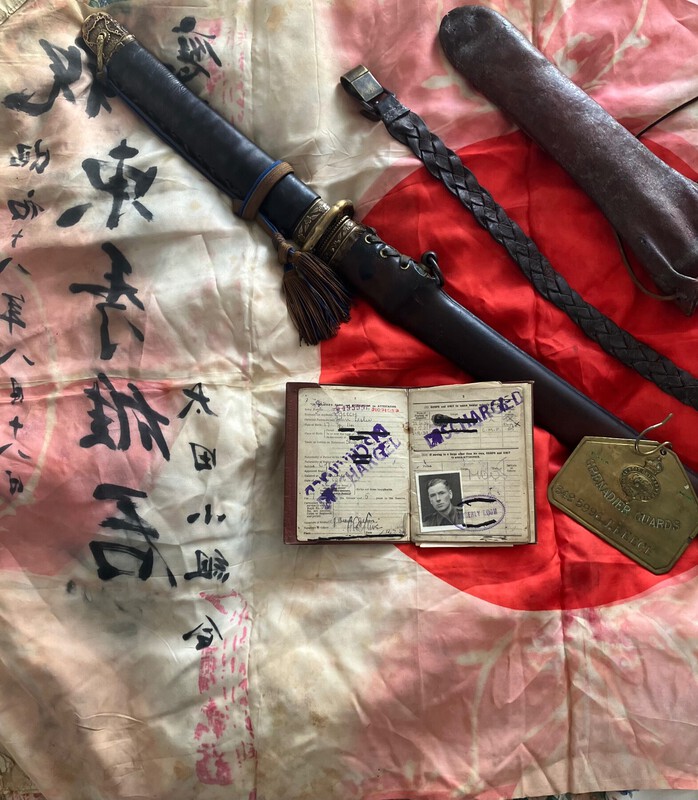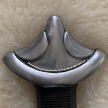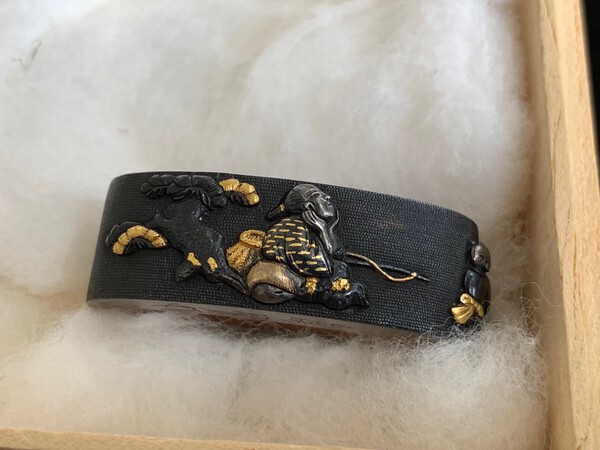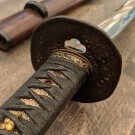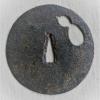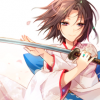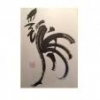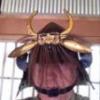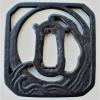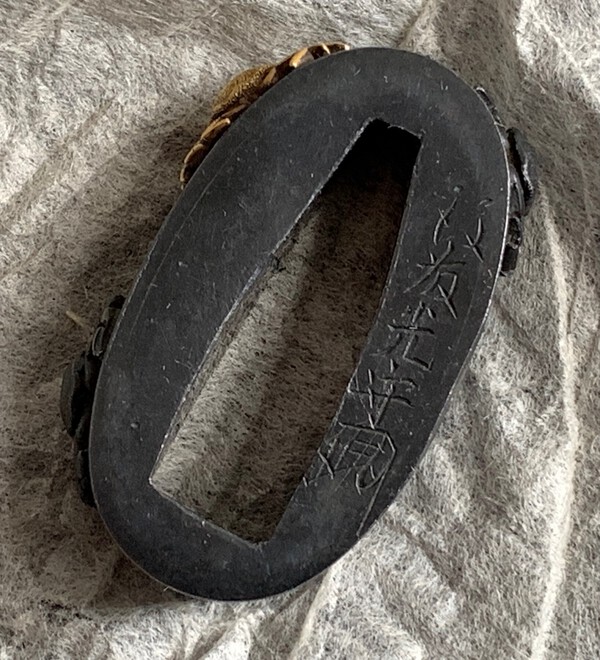Leaderboard
Popular Content
Showing content with the highest reputation on 10/26/2024 in all areas
-
5 points
-
5 points
-
4 points
-
藻柄子入道宗典 – Soheishi Nyudo Soten 行年七十五歳 – At the age of 75 江州彦根住 – Goshu Hikone ju 喜多川 – Kitagawa4 points
-
If memory serves me correctly, original Bo-hi finishing well below the Yokote is a Kantei point for Koto. However, telling if a Bo-hi is original to a sword is another matter entirely.3 points
-
Francis, do have this sword checked out very, very carefully. At least one Kamakura period sword I have seen had bohi finishing short like this. If I remember correctly it was a Go Yoshihiro... BaZZa.3 points
-
Yes, everything is lacquered, there's also traces on the seppa. Probably that's why it preserved so well3 points
-
3 points
-
3 points
-
3 points
-
I should post most of my collection, but i selected a few pieces: Ko-tosho, big, early and unaltered Onin, big and unaltered without much loss of zogan And my pride, tensho koshirae from late Muromachi with its original blade still inside. All lacquered black, simple iron tsuba with most of urushi still in place3 points
-
Dear all I have always found that fuchi are a nice option for those who want to own a better quality piece of Tosogu at a relatively reasonable price. Now I would like to part with part of my fuchi collection. A tsuba by one of these artists is likely out of (financial) reach for most collectors but I hope that some will enjoy the opportunity to buy a fuchi which has been crafted with the same dedication like a tsuba. And yes: my IPhone camera does only give a mere feeling of the quality of the pieces - but does not do them justice! Number 1): Umebachi Mon in gold on a fine shakudo nanako ground Mei: Shonai Ju Kumagai Yoshinobu Saku (庄内住熊谷義信作) Tenpō Kū Nariharu (天保九成春) - Begin of spring in 1838 A piece which has been created for a daimyo! Wonderful workmanship which equals even the greatest machibori masters. Kumagai Yoshinobu was a famous craftsmen who lived from 1790 until 1867. He was the adopted father of Funada Ikkin and probably one of first teachers before he was accepted as apprentice of Gotō Ichijo and became one of his famous pupils. The piece comes with NTHK Hozon papers in a custom-fitted box. Asking price: EUR 420.00 plus shipping costs Number 2): On a fine nanako ground, a fisherman and three karako musicians can be seen Mei: Yamazaki Ichiga (山崎一賀) Hakogaki by Torigoye Kazutaro: Outer lid: 山崎一賀 - Yamazaki Ichiga 縁頭 - Fuchi Kashira Inner lid: 徭 刃宗 壹寸貳分[?] 昭和四十二年七月吉日 - Showa 42 7th month lucky day (July 1967) 右正作也 - Migi shosaku 在耶 Saro [Kao] = used by Torigoye in the 1960s and while traveling Yamazaki Ichiga studied under the sideline Gotō master Jujō and was famous for carving faces and small figures. Asking price: EUR 350.00 plus shipping costs Number 3) My personal highlight at the end: on a fine shakudo nanako ground three crabs come into life. The kani have been so well carved that they almost seem to be real. The whole fuchi is made from shakudo which is quite rare and further attests to the quality of the piece. Mei: Gotō Mitsumori (後藤光守) Asking price: EUR 500.00 plus shipping costs I have not provided measurements as these should not be used for mounting. But I am happy to provide additional information. Shipping costs are: Germany EUR 6.99 EU EUR 16.99 UK EUR 26.99 Worldwide EUR 46.99 Kind regards Chris2 points
-
2 points
-
I believe the Japanese term for this is 樋先下がる (Hisaki-sagaru). It could be giving some direction on school and era, however like John said above then the hi would need to be original. Judging that for me would be very difficult especially on ō-suriage swords. Here is an example on a sword that I have and I am almost certain the hi is added on later.2 points
-
Finally received the bits from the dealer who asked the family if there was any other thing they had . So the Warrant Officer name was John Leslie Beech who enlisted in the Grenadier Guards in 1934 and who later transferred to the Corps of Military Police there is something in his pay book from 1944 but as been blacked out …so I assume he was in Burma ? The flag is well worn like the other items that came with the sword and the colours of the flag as run due to water damage causing it to have some interesting patterns to it .. The flag is named to a Mr Higashi Hideo2 points
-
Correct. Seems to be a feature on his blades. Here is an example that got TH papers for "Den Go". The owner has just had a top level polish in anticipation, I assume, of submission for Juyo. It will be fascinating for me to see how this Shinsa's. Some aspects of the blade are not typical for Go like the Kaen boshi. https://www.kinghous.../go-yoshihiro-katana2 points
-
I highly doubt the bohi termination point has much to do with how much boshi you have left. If on a sword with regular bohi, the kissaki has to be reshaped and includes the bohi, then you'd probably lost all tempering in the point anyways. But I could be very mistaken also.2 points
-
A yari. Weight alone would make it wrong for an arrowhead. ...Or a very large arrow head for a bolt shot from a ballista. Don't know if the Japanese every had or used ballista, even in naval warfare. And why such a quality head on a ballista bolt? Therefore: A yari. __________________________________________________________________ Looks nicely made too. Grooves reduce the chance of suction. Easier to stick, unstick, and stick someone else.2 points
-
Could be 肥州菊池住 = Hishū Kikuchi-jū and the rest of the mei was lost to suriage.2 points
-
2 points
-
2 points
-
Iron Kozuka What is represented here is a bamboo flower container that is used in the Japanese Tea Ceremony. This type is normally hung on the wall of the Tokonoma in a Soan, or Wabi style tea room. A very famous example, and considered to be a prototype of bamboo flower containers is the Enjo-ji, made by Tanaka Soeki (Rikyu) while in attendance to Toyotomi Hideyoshi during the siege of the Hojo in Odawara in 1590. This flower container is named in reference to the bell at the Enjo-ji temple which is cracked. See here for a picture of the flower container in the Tokyo National Museum. http://www.tnm.go.jp...geId=E15&colid=G4217 Because the Enjo-ji flower container is cracked, it leaks a bit, and this is evoked by the four dots, representing water drops, below it. Age: It is likely that this kozuka was made sometime after 1590. My guess is Bunroku through Genna, by which time the new capital in Edo is firmly established. I have seen two other kozuka like it, so I think it is a production item sold to warriors who practiced the Tea Ceremony. Maker: Heianjo Zogan Inlays of copper and silver in addition to the brass suemon (excludes Onin) Inlays being raised slightly above the iron surface (excluded Yoshiro) The archaic and stylistic “Onin-like” nature of the design (Umetada, Higo, etc. are more naturalistic)2 points
-
2 points
-
Your reading is correct; however, the only reference I can found for this tea house is the one in the Kenroku-en garden in Kanazawa. However, that tea house dates to the Meiji period so the relationship to Fujiwara no Teika is probably the correct one.1 point
-
This is a feature typical of the Nambokuchô period. And it is indeed done in case the kissaki is broken and then reshaped.1 point
-
This is an interesting thread! I have recently acquired a hira-zukuri wakizashi with two different styles of bo-hi that both end way back from the kissaki, and I've been wondering as to why too: As others have said though, the hamon is so close to the edge I can't see how in my case reshaping the kissaki would have been the main motivation for this blade or the OP. If the bo-hi had been added to remove some forging flaws though (which would make sense on mine because there are still quite a few kizu present) then perhaps it just didn't need to go any further, perhaps to prevent weakening the point/taking more time for no reason?1 point
-
Here's another from the 3rd page of that Rinji Timeline thread:1 point
-
Adam, that is a beautiful Hiromasa! Looks like I should have read that old Rinji thread before posting on it. It's got some outdated info that I'll have to update. The Contingency model was designed in 1938 and production and sales began 22 August 1940. Unveiling the Rinji-seishiki Sword in 1940 - Nick Komiya It's taking me a while to find his post revealing the Uniform regulation change that allowed, even required, simplified fittings designs due to war shortages and Allied bombing damage to the industry. I'll post when I find it (or maybe @Kiipu has the reference??) My gut feel is this style was due to that relaxation of the mil specs and request to simplify weapons production. Update: Found it! From Rinji-seishiki to Daiyou-seishiki of Weapon Specs - Nick Komiya It was 1943: "The Daisei-Heiki Era Then by 1943, this kind of choice would no longer be available, as the standard quality stocks ran out. By this time, even primary weapons like rifles were routinely produced in nonstandard specs. Such symptoms were no longer of a "Rinji" nature but a chronic one, expected to get even worse in the future. So they officially coined a new phrase to describe these items of “compromised specs” and called them “Daiyo-Seishiki-Heiki” 代用制式兵器, (Substitute-Spec Weapons), which they abbreviated into the term, “Daisei-Heiki” 代制兵器." "These downgraded spec standards were applied to items that had little impact on military performance, like weapon accessories such as muzzle lids, rifle oilers made of resin instead of brass, belts, holsters and ammo pouches made of rubberized canvass instead of leather, woolen uniform items replaced by cotton, felt or even silk mixed in wool."1 point
-
Given the simplification of fittings & reduction in quality, a last stage variant using less man hours seems most likely.1 point
-
Id also be tempted leave it as my thoughts are they wont pass it if stands out as an oddball from the norm. Also points others have made. Looks a real nice blade though, the hamon very much reminds me of an Hizen Tadakuni blade, as mentioned. This is the trouble with buying unpapered blades. One always owns it with questions and a demand for authentification. A lot of Mumei blades can have the same issues, even with papers. As in narrowing it down to one smith. So long as you paid gimei money for it then i guess most here would be happy to own it. Would suggest assuming gimei, look at the work and see if anything else fits better. See what else comes up. Still, i cant get away from thinking its maybe a oddball Hizen with a ? If you do send it to Shinsa then i hope you prove us doubters wrong but the odds are not in your favour. Maybe try NTHK if your going to do it.1 point
-
1 point
-
No, there's no kozuka slot. The saya Is plain with horn koiguchi, kurikata and kaerizuno, kojiri Is missing1 point
-
George Thats good to hear Thanks Brian i appreciate that you moved it1 point
-
1 point
-
Definitely looks like Bubba got ahold of this one. Hopefully he left the blade alone.1 point
-
1 point
-
Come on you know you want one! They certainly make an entrance statement! Now that is a DOOR HANDLE ! https://silkroadyamb...ndle-grab-old-style/ https://www.etsy.com...r-handle-pull-katana [PS THEY COME IN THREE COLOURS AND MATCHING PAIRS OR SINGLE] I wanted one but could not justify the expense so I just used a cast tsuba. [Also over on the cast tsuba thread]1 point
-
Alex, looks to me like Noshu ju Kanetoshi. But Seki is better. The mei is s bit rough. There are two of this name, but yours looks to be Kumazawa (top one). he more often signed " Kumazawa Kanetoshi". The other aspect of his work is the inverted "taka-no-ha" filing on the nakago. KANETOSHI (兼俊), Shōwa (昭和, 1926-1989), Gifu – “Kanetoshi” (兼俊), “Ikkōsai Kanetoshi” (粋光斎兼俊), real name Kumazawa Shun´ichi (熊沢俊一), born April 20th 1899, gō Ikkōsai (粋光斎), he worked as guntō smith. KANETOSHI (兼俊), Shōwa (昭和, 1926-1989), Gifu – “Kanetoshi” (兼俊), real name Murayama Kinokazu (村山喜之一), born August 3rd 1905, he worked as rikugun-jumei-tōshō and died February 23rd 1978, jōkō no retsu (Akihide), Second Seat at the 6th Shinsaku Nihontō Denrankai (新作日本刀展覧会, 1941)1 point
-
1 point
-
1 point
-
1 point
-
1 point
-
1 point
-
1 point
-
1 point
-
1 point
-
I'm planning to go to Japan again in 2025, in the fall of course, and of course this time to the DTI.1 point
-
1 point
-
It somehow relates to me on a different level than purely the appreciation of the technique and art of it or the aesthetics. For me it represents the warrior and all of the challenges that same warrior would face during the time he would wear it, but still faced all of those dangers with seeming indifference.1 point
-
1 point
This leaderboard is set to Johannesburg/GMT+02:00


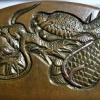

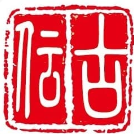






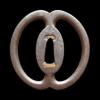
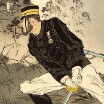

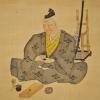
























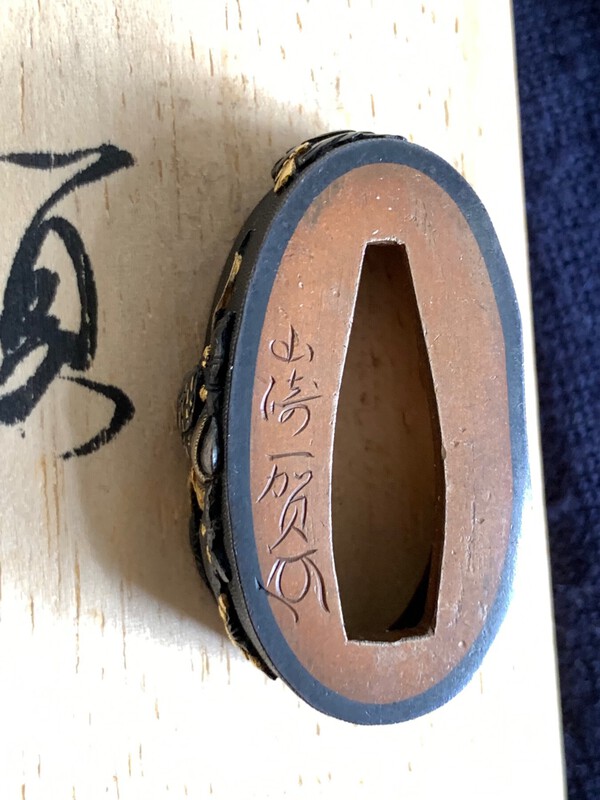




p.thumb.jpg.f6680464f3c7322002703e8bc0642d46.jpg)
